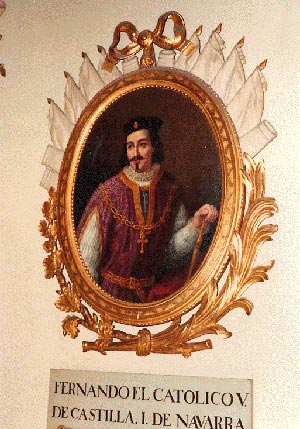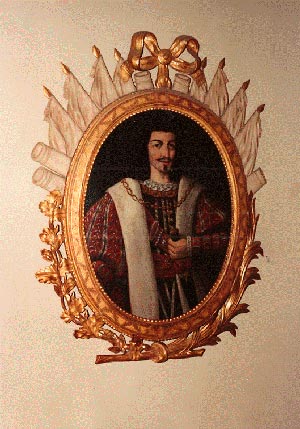The piece of the month of June 2022
DOCUMENTS OF THE file MUNICIPAL OF PAMPLONA THAT CONTRIBUTE TO THE knowledge OF THE PAINTING OF NAVARRA OF THE 19TH CENTURY: NEW WORKS OF THE PAINTER MARIANO SANZ Y TARAZONA
(1829-1876)
Ana D. Hueso Pérez
file Municipal of Pamplona
The documents kept in the archives often bring new developments, so that the information contained in them can complement and contribute to a better knowledge of topics whose Degree of research is incipient, and can also modify initial approaches that historiography has been consecrating.
Two documents from the Municipal School of Drawing, kept in the Municipal file , reveal that the painter Mariano Sanz y Tarazona (1829-1876) is the author of two of the works that are part of the pictorial heritage of the City Council of Pamplona: the Corpus Christi Procession of 1849 and a Portrait of Ferdinand the Catholic.
The Corpus Christi Procession of 1849 has traditionally been attributed to the painter Miguel Sanz y Benito (1794-1864), who was the first director of the Public Academy of Drawing from its foundation in 1828 until his retirement in 1863, and father of Mariano Sanz Tarazona. Some historians have supposed, as had been usual on other occasions, that the Pamplona City Council commissioned this painting to immortalize the day on which the new, large and luxurious canopy of the Corporation for the Corpus Christi procession, held on June 7, 1849, first took to the streets, replacing the old one that had existed until then. Others confirm the acquisition of this canvas by the City Council from the author, who, apart from his work professor, was an outstanding painter in Pamplona in the second third of the 19th century, executing works of interest for their iconographic, historical and documentary value.
The authorship of this work and the manner of its acquisition are unraveled in a letter that Miguel Sanz himself sent to the City Council of Pamplona on October 7, 1849, in which he states:
That having his son Mariano of 19 years of age dedicated to the profession of drawing and painting, whose uncommon advances he has demonstrated and corroborates with the original little work that he has just made of the new Palio and procession of the Corpus (seen from the corner of the house of Mr. Garcia, in the place of The Constitution), that he has the honor of dedicating to VS., begging him to deign to accept it as the least test of his eternal gratitude, trusting that he will dissimulate with his usual indulgence the faults that it may have for being of complicated composition and fleeting imagination.
[...] and wishing to send his son for a couple of years to one of the main capitals to acquire higher knowledge in his profession and considering his own efforts and sacrifices to be impotent, he sees the need to turn to the munificence of Your Majesty, imploring your powerful protection and support so that you may deign to grace him by granting him that pension that your notorious kindness will dictate for the aforementioned two years so that he can meet the necessary expenses....
The City Council only agreed to give Sanz six hundred and forty reales de vellón in sample in gratitude for the painting reference letter.

Pamplona City Hall canopy built in 1849. Mariano Sanz Tarazona (1849).
The Portrait of Ferdinand the Catholic was considered to be the work of the painter Diego Díaz del Valle, who was commissioned by the City Council of Pamplona to create a gallery of portraits of the kings who had reigned in Navarre since its incorporation into the Crown of Castile, in order to decorate the so-called "summer consistory". Díaz del Valle presented receipt on May 27, 1797 for the portraits in oil on board of Fernando the Catholic, Felipe I, Felipe III, Felipe IV, Felipe II, Felipe IV, Luis I, Fernando VI, Carlos III, Carlos IV and María Luisa de Parma, importing its work 275 duros and adding 16 duros more that had of cost the conduction and the construction of two crates for the transport. It is deduced that Díaz del Valle had already sent the portraits of Charles V and Philip II, which he does not mention in the receipt presented, resulting in a total of 13 works that made up the gallery of portraits, as stated on the back of the cartouche identifying Charles IV.
The various changes of location of the collection, motivated by works in the old Town Hall until its demolition in 1951, may be one of the possible causes of its loss, with the disappearance of the portrait of Louis I -whose descriptive cartouche was recovered by purchase in recent times-, as well as that of Charles III and the identifying cartouches of both Charles III and Philip I the Handsome.
When the new building was built in 1953, the gallery, already made up of 11 portraits, was placed on the walls of the double flight of stairs leading to the main floor, at which time we suppose that the portrait of another royal personage, without identifying cartouche and of unknown provenance, was incorporated, which is clearly related to those executed by Díaz del Valle. The last transfer of the collection, due to a new decorative approach of the Casa Consistorial in 2016, led to the update of the inventory and the identification of the unknown royal personage. A simple visual recognition made us think that it was once again Ferdinand the Catholic who was portrayed, as he corresponds to the most popular iconography of the monarch, wearing average mane, black cap and the thick gold "shoulder" necklace, as he was rarely represented with the Golden Fleece, despite being named knight of the Order in 1473.
The mystery would soon be cleared up thanks to M.ª Jesús G.ª Camón, who at that time was starting her research on the first photographers who settled in Pamplona, among them Miguel Sanz y Benito, author of the only daguerreotype made in the city known to date. When expanding the limits of his study towards the family saga of the Sanz family, he found the document that once again accredits Mariano Sanz y Tarazona as the author of said portrait, in which he states to the City Council that, in gratitude for his appointment as Director of the School of Drawing on the occasion of his father's retirement,
has painted the first picture of those that appear in the conference room of the Kings, belonging to D. Fernando de Aragón, who was the first of this province to have occupied it since the expulsion of the old monarchs. This work, made with the presence of the historical costumes of that time, represents the mentioned personage in the most proper way that the exponent has been possible to reach [...]. He begs VS. to accept it with the benevolence he is accustomed to, as a slight sample of his gratitude, thus supplicating the lack of merit that his execution may have.
The City Council, in an ordinary session held on June 28, 1864, agreed to accept the gift, instructing that the painter be thanked and that "the painting be placed in its place, keeping the old one". If this instruction was carried out as the City Council agreed, it can be assumed that the work of Mariano Sanz would be placed on the cartouche designed by Díaz del Valle in 1797, removing only the portrait he painted.


New portrait (1864) Old portrait (1797).
It is beyond our reach to describe here the life of Mariano Sanz Tarazona. Picking up the echo of the specialists, who warn that the work as a painter of this professor of the School of Drawing is still to be discovered and identifying two more works in the light of the documents kept by the Municipal file of Pamplona, we have only tried to contribute to conveniently value his facet as an artist and to the best knowledge of the Navarrese painting of the 19th century.
SOURCES AND BIBLIOGRAPHY
file MUNICIPAL OF PAMPLONA/Drawing School, Leg.1
file MUNICIPAL OF PAMPLONA/Register of the deceased n.º 17- p. 108.
file MUNICIPAL OF PAMPLONA/Libranzas, 1797.
AZANZA, J. J. and SANZ TIRAPU, M., "Aproximación al método de teaching en la escuela de dibujo de Pamplona: la Cartilla de Miguel Sanz y Benito", yearbook del department de Historia y Teoría del Arte, U.A.M, vol. XIV, 2002, pp. 231-273.
FERNÁNDEZ GRACIA, R., Diego Díaz del Valle: A painter from Cascante in the century of lights..
MOLINS MUGUETA, J. L., Pamplona-Iruña: Casa Consistorial, Pamplona, Pamplona City Council, 1988, pp. 100-104.
MONCLOVA GONZÁLEZ, F. J., "Aproximación a la obra del pintor, decorator y arquitecto Diego Díaz del Valle", Revista del Centro de programs of study Merindad de Tudela, 22, 2014, pp. 59-78.
MORALES SOLCHAGA, E., "Hacia un panorama general de la pintura navarra durante los siglos del Barroco", Revista Príncipe de Viana, 246, 2009, pp. 41-66.
MORTE GARCÍA, C., "La imagen de Fernando el Católico en el Arte: El tiempo vivido y el tiempo recreado (1452-1700)", in EGIDO, A. and LAPLANA, J. E. (coords.), La imagen de Fernando el Católico en la Historia, la Literatura y el Arte, Zaragoza, Institución Fernando el Católico (CSIC), 2014, pp. 280-374.
MURUZÁBAL DEL SOLAR, J. M., "Forgotten Navarre artists: Mariano Sanz y Tarazona, son of a painter," Diario de Navarra, May 31, 2016, p. 61.
MURUZABAL DEL SOLAR, J. M., "Forgotten Navarre artists: Miguel Sanz y Benito," Diario de Navarra, March 28, 2016, p. 58.
MURUZÁBAL DEL SOLAR, J. M., "Mariano Sanz y Tarazona: El Viacrucis de Santa María de Sangüesa", Revista Zangotzarra, 18, 2014, pp. 131-147.
PALACIOS ZUASTI, J. I., "A portrait is missing in the Pamplona City Hall", Diario de Navarra, September 8, 2016, p. 15.
REDÍN ARMAÑANZAS, A., "teaching of the arts in Pamplona (1800-1939). La Escuela de Artes y Oficios", in Primer meeting sobre Historia de la Education en Navarra (2-3 November 2000), Pamplona, Gobierno de Navarra-Sociedad de programs of study Históricos de Navarra, pp. 153- 163.
ZUBIAUR CARREÑO, F. J., "Contemporary painting in Navarra. Historiography (1995-2005)", Revista Príncipe de Viana, 239, 2006, pp. 861-870.
